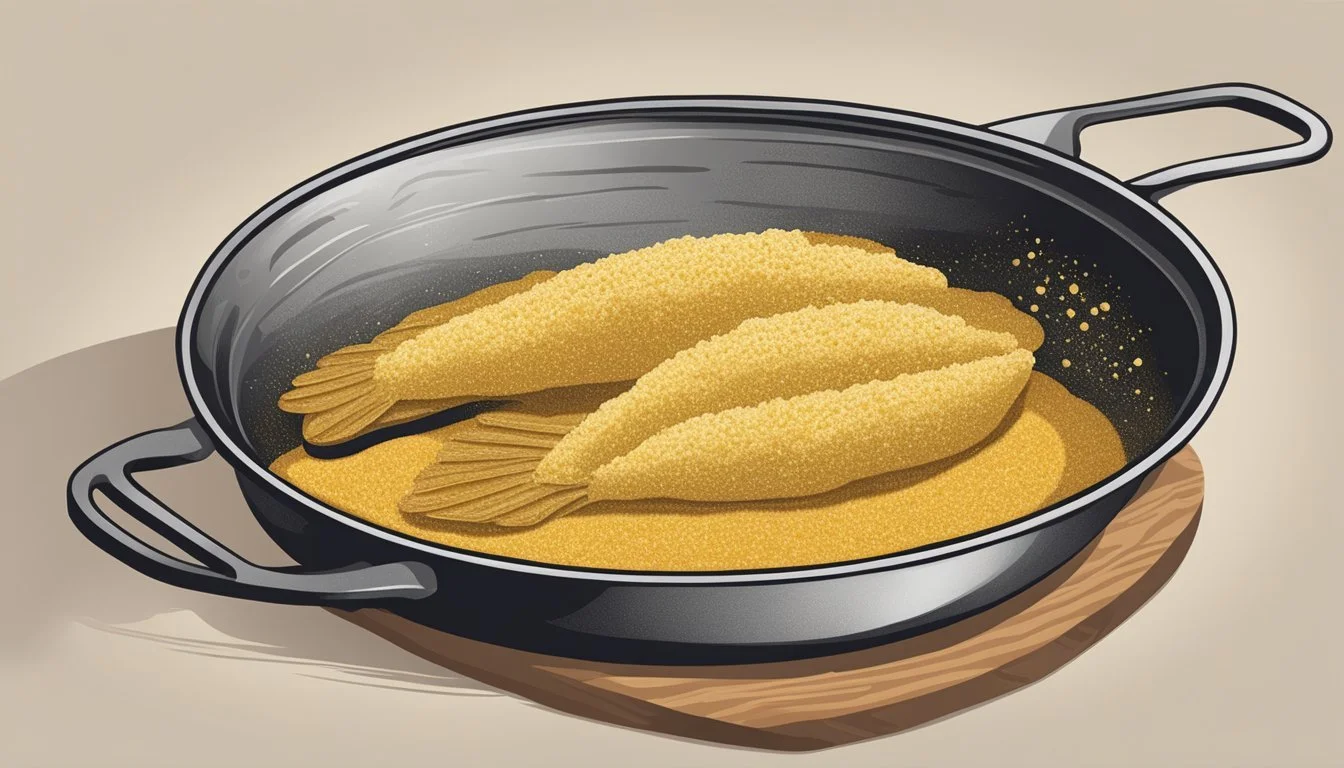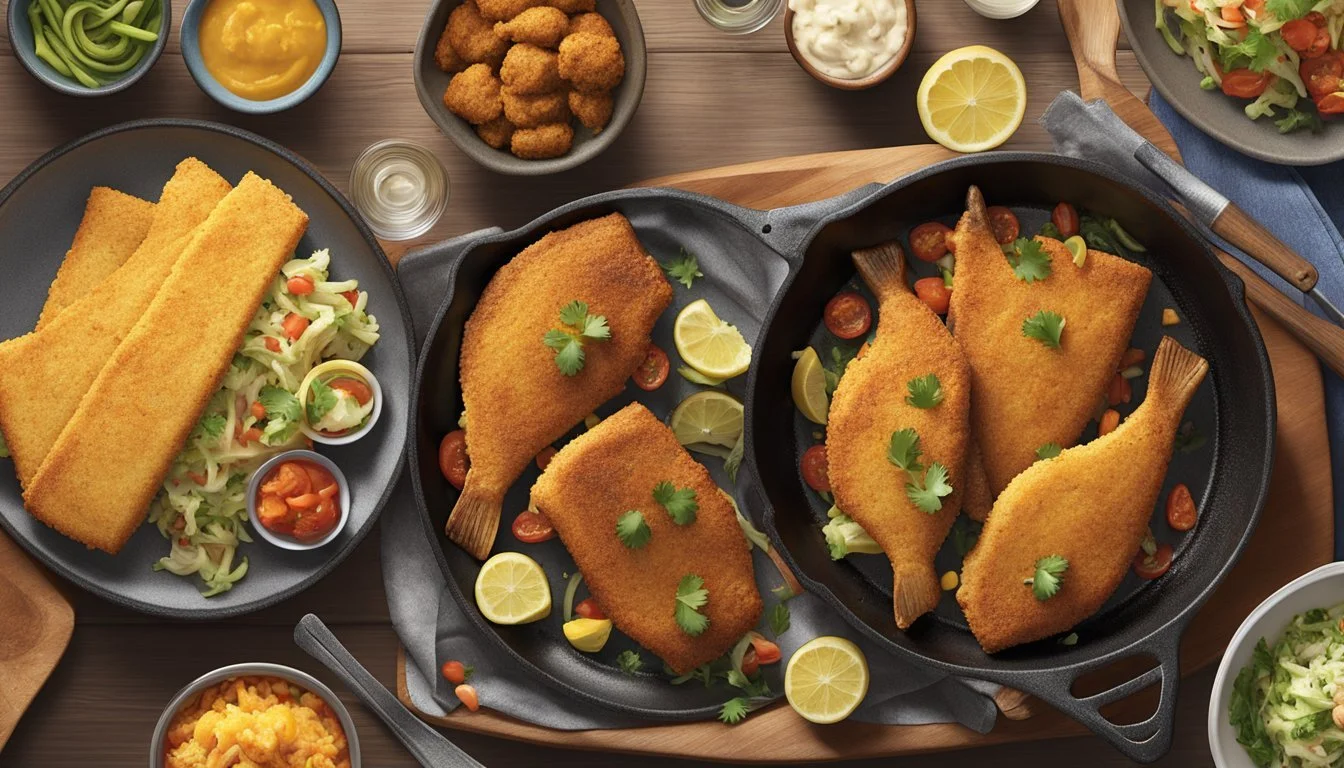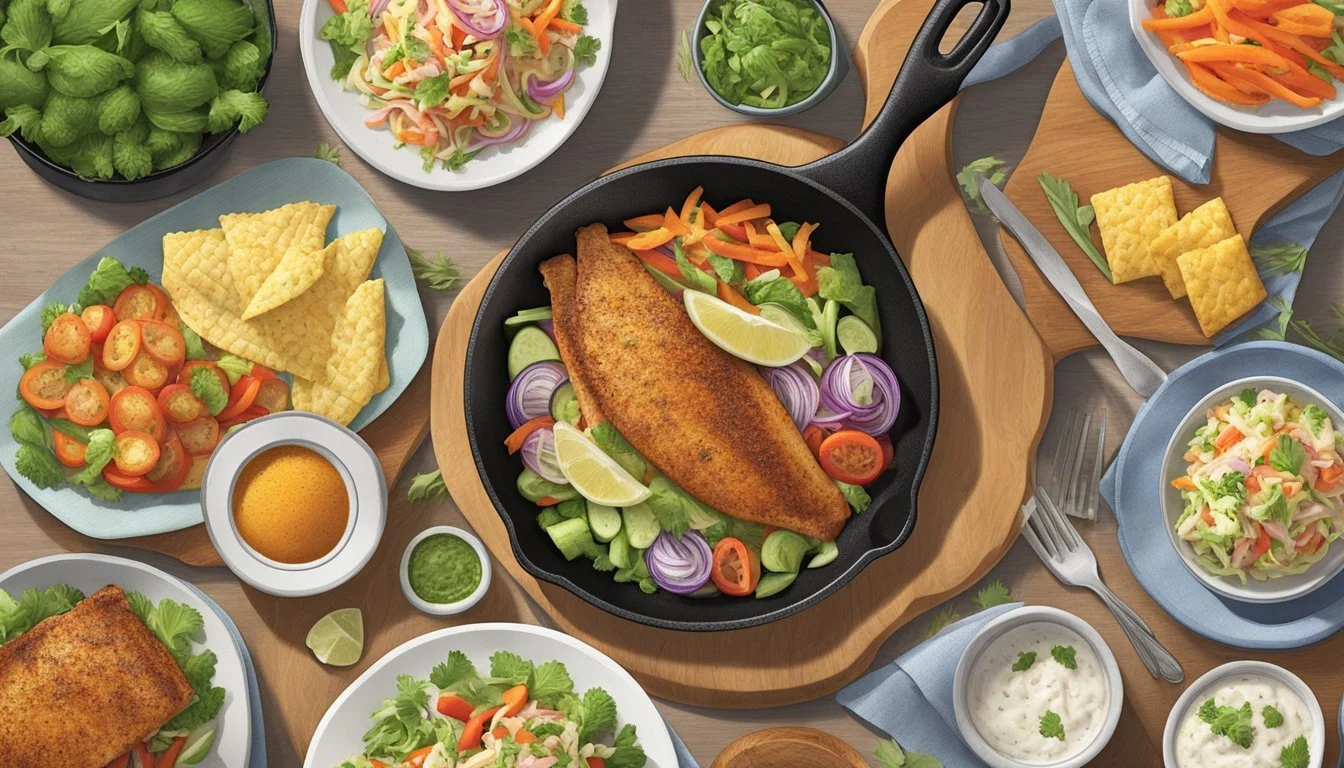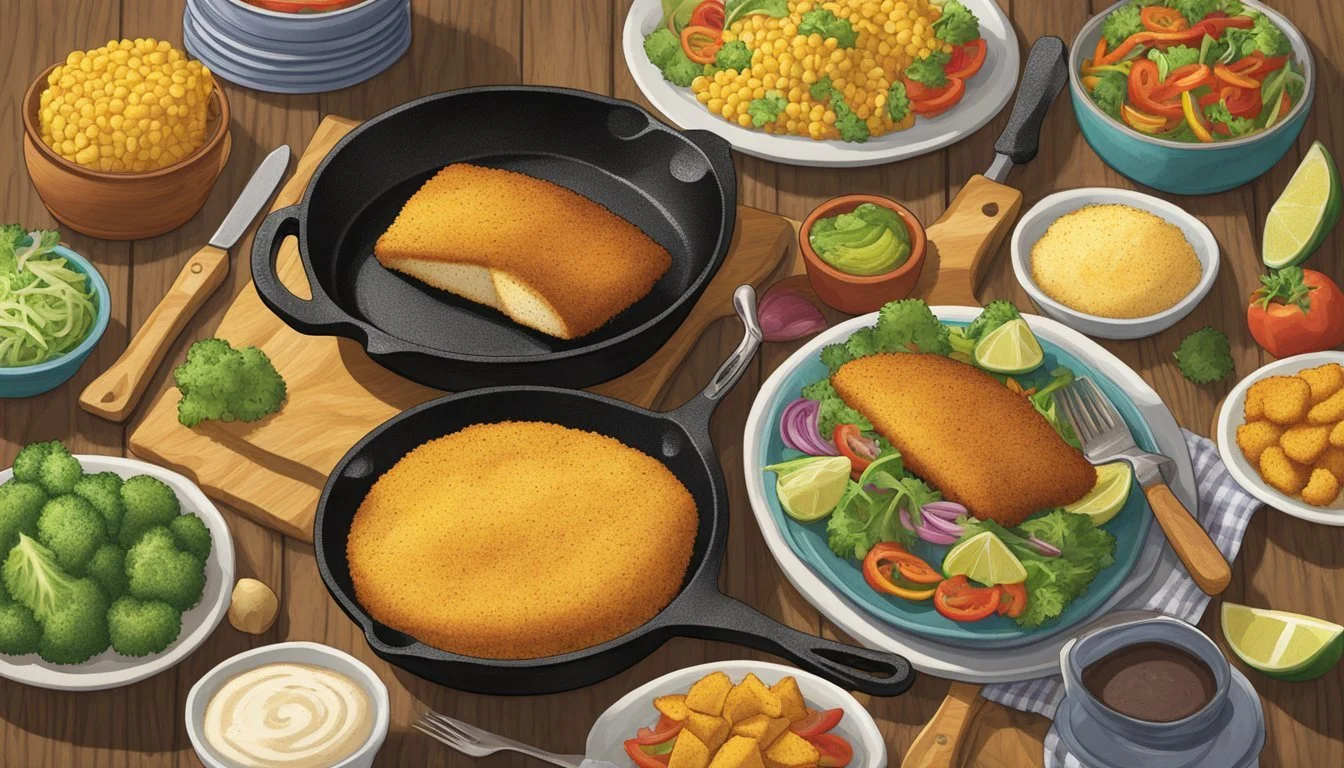How to Fry Catfish with a Texan Twist
A Guide to Classic Southern Cooking
Frying catfish holds a storied place in Southern culinary tradition, with Texas adding its own unique flair to this iconic dish. Catfish's mild, sweet flavor and firm, dense texture make it the ideal candidate for frying, achieving a delightful contrast between the crispy exterior and succulent interior. The approach Texans take often involves a combination of well-seasoned cornmeal and a deep understanding of the frying technique—ensuring the fish is neither greasy nor overcooked, but instead perfectly golden and crisp.
In Texas, the nuances of frying catfish are passed down through generations, with each cook adding their personal twist to the process. This often includes a signature blend of spices that go beyond salt and pepper, incorporating elements like cayenne for heat or a hint of lemon pepper for a zesty kick. The preparation is an artful dance of timing and temperature control, typically using a cast-iron skillet or Dutch oven, which are valued for their even heat distribution.
While the essence of Southern cooking is a respect for tradition, exemplary fried catfish is as much about the quality of the ingredients as it is the method of preparation. Selecting the right type of catfish, typically farm-raised for its consistency and mild flavor, and ensuring the frying oil is at the optimal temperature are key steps towards achieving that sought-after crispy texture with a taste of Texas in every bite.
Choosing the Right Catfish
When aiming for that authentic Texan fried catfish, selecting the proper type and quality of catfish is a critical first step. It influences flavor, texture, and overall satisfaction.
Understanding Different Catfish Species
The two most commonly consumed species of catfish in Texas are the Channel Catfish and the Blue Catfish. Channel catfish are well-regarded for their excellent flavor and firm texture, making them ideal for frying. Blue catfish, often larger, offer a milder taste and are also suitable for a classic Texan fry-up.
Wild-Caught vs Farm-Raised Catfish
Wild-caught catfish are often praised for a more nuanced flavor, influenced by their natural diet. They can be a more sustainable choice, but availability may vary by season. Farm-raised catfish, on the other hand, are more consistently available and are often more affordable. They are raised in controlled environments, leading to a cleaner taste, which can be a canvas for the bold flavors inherent in Texan cuisine.
Wild-Caught Catfish:
More varied flavor profile
Seasonally available
Farm-Raised Catfish:
Milder, cleaner taste
Consistent year-round availability
Preparing Catfish Fillets for Cooking
Whether you choose wild-caught or farm-raised, preparing the catfish fillets correctly is crucial. For frying, fillets should be fresh or properly thawed if previously frozen. They must be patted dry to ensure the breading adheres well and results in the desired crispiness. It's important to trim any excess fat, which could affect the flavor balance and frying performance.
Gathering Your Cooking Supplies
To ensure authentic Texan fried catfish, one should meticulously select the right oil for frying and choose robust cookware that can handle the process efficiently.
Selecting the Right Oil for Frying
Choosing the ideal frying oil is crucial for achieving that perfect crispy exterior on catfish without compromising the delicate flavor of the fish.
Peanut Oil: Renowned for its high smoke point and nutty essence, peanut oil is a popular choice in Texan kitchens, which can endure the frying process without burning.
Vegetable Oil: A more neutral option is vegetable oil; it's widely accessible and also has a high smoke point, making it suitable for frying.
Canola Oil: For health-conscious cooks, canola oil presents a heart-healthy alternative with a mild flavor and high smoke point.
When choosing oil, one must consider the smoke point and flavor profile to complement the catfish.
Choosing Your Cookware
The vessel used for frying catfish is as critical as the oil.
Cast Iron Skillet: A heavy-duty cast iron skillet ensures even heat distribution for a consistent golden-brown finish.
Dutch Oven: With its deep structure, a Dutch oven is excellent for maintaining consistent oil temperatures throughout the cooking process.
Deep Fryer: For those preferring a specialized tool, a deep fryer offers precise temperature control, making it an ideal appliance for frying.
Frying Pan: A simple frying pan can also suffice, though it requires diligent temperature management to avoid oil overheating.
For an authentic Texan fried catfish experience, the cookware should offer stability, heat retention, and apt depth for submerging the fish.
Preparing the Dredge and Coating
The key to a crispy and flavorful catfish lies in the blend of the dredge used for the coating. This involves a balance of dry and wet ingredients to ensure a perfectly seasoned crust.
Mixing the Dry Ingredients
They begin by combining the dry ingredients to create a well-seasoned flour mixture. This foundation will give the catfish its signature texture and flavor.
Flour: 1 cup of all-purpose flour for a light base.
Cornmeal: 1 cup of yellow cornmeal adds crunch.
Seasoning:
1 tsp of kosher salt for a clean salty note.
1 tsp of black pepper for heat.
1/2 tsp of cayenne for a Texas kick.
1 tsp of paprika for color and mild sweetness.
1 tsp each of garlic and onion powder for savory depth.
They thoroughly mix these ingredients to ensure an even coating on each catfish fillet.
Creating the Wet Mixture
Following the dry mix, they create a wet mixture, which acts as the adhesive for the cornmeal and flour blend.
Buttermilk: They use this for soaking the fillets, ensuring richness and tanginess.
Egg: One egg is beaten into the buttermilk to improve coating adherence.
They ensure the fillets are fully submerged in this mixture before moving them to the dry ingredients for dredging. This step is crucial to achieve a well-coated, flavorful Texas-style fried catfish.
Seasoning the Catfish
Properly seasoning catfish is essential for achieving that authentic Texan flavor. It requires a mix of traditional spices and a marinating process that maximizes the taste, locking in a bold and savory profile.
Applying Seasoning for Maximum Flavor
One begins by liberally sprinkling a combination of salt, lemon pepper, and cayenne pepper. For those craving a southern flare, Cajun seasoning or seasoned salt can replace plain salt to add another layer of complexity. Here's a quick guide to the proportions:
Salt or Seasoned Salt: 1 tablespoon
Lemon Pepper: 1 teaspoon
Cayenne Pepper: 1/2 teaspoon
Optional: A pinch of cajun seasoning for an extra kick
It's important to evenly coat the catfish fillets with these spices, ensuring every bite is flavorful.
Marinating with Buttermilk
Marinating the catfish in buttermilk serves a dual purpose: it tenderizes the fish and provides a base for the seasoning to adhere. For an added dimension of taste, a few dashes of hot sauce can be mixed into the buttermilk.
One should allow the fish to sit in this mixture for at least an hour, which will:
Enhance the catfish's natural flavors
Mellow out the spiciness of the cayenne pepper
Incorporating buttermilk and hot sauce not only amplifies taste but also contributes to the final texture of the fish after frying.
Breading and Frying Techniques
In the art of frying catfish, the focus lies on creating a crispy, golden coating using a seasoned cornmeal crust and perfecting the frying process for that ideal crispiness. Ensuring the oil is hot enough and the breading is adhered evenly are fundamental for success.
Coating the Catfish Evenly
To ensure the catfish fillets are coated evenly, start by preparing the breading mixture. One should combine dry ingredients such as cornmeal, flour, and a blend of Texan spices like cayenne pepper for a kick in a large bowl. It's essential to ensure each catfish fillet is patted dry before dredging it through the breading mixture; this helps the cornmeal coating to adhere better thus prevent sogginess. For an even coat, press the fillet gently into the mixture, then shake off any excess to avoid clumps that won't fry up evenly.
Achieving the Perfect Fry
When it comes to frying, the temperature of the oil is crucial—it should be steady around 350ºF. Use a thermometer to check the oil’s temperature: too hot, and the breading burns before the fish is cooked; too cool, and the catfish absorbs the oil, becoming greasy. A heavy-bottomed pan, like a cast-iron skillet, is ideal for maintaining a constant temperature. Lower the breaded fillets carefully into the hot oil in batches to avoid overcrowding, which can lower the oil's temperature rapidly. A successful fry is evident when the catfish turns a crispy golden brown and the fillets float to the surface, usually after about 5-7 minutes per side. Between batches, allow the oil to return to the optimal temperature to ensure the crispy fried catfish is consistent in texture and taste.
Serving and Accompaniments
When presenting fried catfish, the true Southern experience is not complete without considering the proper accompaniments and side dishes that complement the flavors and textures of the fish.
Presentation and Pairing
Fried catfish is best served hot and crisp, typically garnished with lemon wedges to add a fresh, tangy counterpoint to the rich, golden coating. One might often find it paired with a heap of fries or hush puppies, the latter being a quintessential part of Southern cuisine. A fantastic way to elevate the meal is to include collard greens, which bring a hearty and nutritious balance to the plate. For sandwiches, placing a fillet between buns with slaw and a smear of tartar sauce creates a satisfying catfish sandwich.
Homemade Sides and Sauces
Sides:
For a traditional touch, one can prepare a side of fried okra, turning a simple vegetable into a crunchy delight.
Mac and cheese offers a creamy and comforting texture alongside the fish.
A potato salad or macaroni salad can serve as a cool and refreshing contrast.
Sauces:
Homemade tartar sauce, mixing mayonnaise with pickles, onions, and lemon juice, provides a creamy condiment with a tangy kick.
Cocktail sauce with a horseradish base complements the seafood flavor effectively.
A simple dash of vinegar can enhance the fish fry by cutting through the oiliness with its sharpness.
Together, these chosen sides and sauces not only complete the dish but also reflect the varied and rich heritage of Southern cuisine.
Finishing Touches
Achieving the perfect finish when frying catfish involves precise draining and resting procedures, along with carefully chosen garnishes that bring out the authentic Southern charm.
Draining and Resting the Fried Catfish
After carefully removing the catfish from the hot oil, they should be placed on a wire rack over a baking sheet, which allows the excess oil to drain away effectively without making the crust soggy. The use of paper towels beneath the rack will soak up the drippings, ensuring a crispier finish. To maintain optimal temperature and texture, fried catfish may be kept in a preheated 200˚F oven where they can rest fully, maximizing their crispness and heat without becoming dry.
Garnishing for a Southern Flair
Garnish plays a significant role in adding that zesty Texan twist to the dish. Arrange lemon wedges on the side for a fresh, acidic contrast that complements the rich flavor of the fish. A sprinkle of Old Bay seasoning can offer an additional kick that elevates the taste profile. For a truly Southern experience, serve the catfish accompanied by a side of heartwarming baked beans, creating a classic pairing that rounds out the meal.
Health and Nutritional Considerations
When frying catfish, understanding the impact on health and nutrition is essential. The methods and ingredients used can significantly affect the dish's calorie content and nutritional value.
Understanding Calories and Fats
Frying catfish typically involves cooking the fish in a substantial amount of oil, which increases the calorie count and the intake of fats. The type of oil used can alter the health implications:
Peanut Oil: High in monounsaturated fats, which can be heart-healthy in moderation.
Vegetable Oil: Usually a blend of oils, including soybean oil, which is high in polyunsaturated fats.
A 3-ounce serving of fried catfish can contain around 150-200 calories with varying amounts of fats depending on the cooking method.
Substituting Ingredients for Healthier Alternatives
Health-conscious cooks may consider these substitutions:
Whole Milk: Replace with low-fat or skim milk to decrease calorie and fat intake.
Oils: Opt for oils with a higher smoke point and healthier fat profile, such as avocado oil.
By being mindful of ingredients and preparation techniques, one can enjoy fried catfish while managing its impact on health and nutrition.
Tips for Leftovers and Reheating
When it comes to enjoying fried catfish a second time, the right storage and reheating techniques are crucial to maintain its distinctive Texas crunch and flavor.
Storing Leftover Fried Catfish
Proper storage is essential to preserve the quality of leftover fried catfish. The catfish should be allowed to cool to room temperature. Then, it should be transferred to an airtight container and stored in the refrigerator. For best results, leftovers should be consumed within 2-3 days.
Key Points:
Cool to room temperature before storing.
Use an airtight container to retain freshness.
Refrigerate and consume within 2-3 days.
Best Practices for Reheating To Preserve Crispiness
Reheating fried catfish can be a delicate process if the goal is to retain its crisp exterior and moist interior. An air fryer is particularly effective for this task, but a conventional oven with a baking sheet lined with foil can also work well. If an oven is used, placing the catfish on a wire cooling rack on top of the baking sheet allows for even heat distribution.
For Air Fryer:
Preheat to 350°F.
Reheat for 3-4 minutes, checking frequently.
For Oven:
Preheat to 350°F.
Place on wire cooling rack above a lined baking sheet.
Heat for 10-15 minutes, checking for crispiness.
Maintaining the integrity of the catfish's texture is all about gentle reheating and avoiding overcooking. Whether using an air fryer or an oven, monitoring is key to ensure it heats through without becoming dry.
Alternative Cooking Methods
When one aims to cook catfish without using a deep-fryer, baking and air frying are excellent alternatives that offer a healthier approach and can also impart unique textures to the fish.
Baking Instead of Frying
Baking catfish is a method that can result in tender and flaky fish with less oil. One begins by preheating the oven and preparing a baking sheet, which is often lined to prevent sticking and to facilitate easy cleanup. The catfish should be seasoned according to one's preferences and then placed onto the baking sheet. The fish is then cooked in the oven until it reaches the desired doneness, typically between 15 to 25 minutes at 350-425°F (depending on thickness and desired crispness).
Pros of Baking:
Lower Fat Content: Less oil is used in baking, which reduces the overall fat content of the dish.
Simplicity: Baking is a straightforward process that doesn’t require constant attention.
Cons of Baking:
Texture: Baked catfish might not achieve the same crispy exterior as deep-fried catfish.
Exploring the Air Fryer Option
An air fryer provides a method to cook catfish that is similar to deep-frying, but with significantly less oil. To cook catfish in an air fryer, one should first preheat the device if recommended by the manufacturer. The catfish is seasoned and can be lightly brushed with oil or cooking spray. The fish is placed in the air fryer basket, ensuring that pieces do not overlap for even cooking.
Cooking Time and Temperature:
Preheat: To 375-400°F (as per air fryer instructions)
Cook: For about 10-12 minutes (time may vary depending on thickness), flipping halfway through.
Pros of Air Frying:
Crispiness: Air frying can achieve a crispy surface similar to deep-frying.
Efficiency: It is a quicker method than baking and typically requires less preheating time.
Cons of Air Frying:
Size Limitations: The basket size may limit the amount of catfish that can be cooked at once.
Inconsistency: Without proper space between pieces, the fish may cook unevenly.
Fishing for Catfish
Successfully catching catfish is the first essential step towards crafting that perfect Texan-style dish. The process not only lays the foundation for cook time but also for the flavor and texture of the final meal.
Tips for Catching Catfish
Location: Catfish thrive in areas where water is warmer and murkier, often residing near the bottom. They prefer structures like river bends, where water depth changes and debris accumulates, which provides good hunting grounds for anglers.
Baits and Lures:
Live baits such as nightcrawlers, minnows, and leeches are highly effective.
For larger catfish, use cut baits like pieces of fish or shrimp.
Stink baits can attract catfish by mimicking the smell of their natural food.
Timing: Catfish are often more active during early morning or late evening hours. However, they are also known to bite during overcast days or at night.
Clean and Prep for Cooking
Cleaning:
After catching the catfish, it's crucial to clean them properly. Begin by making a cut behind the gills and move towards the belly.
Remove the innards, and then proceed to skin the fish if desired.
Preparation Time:
Rinse the catfish fillets thoroughly to ensure all traces of blood and remnants are gone.
Pat the fillets dry, which is critical for a crisp-fried exterior.
By following these steps, one ensures that the catfish is prepped and ready to take on that signature Texan twist during cooking.








